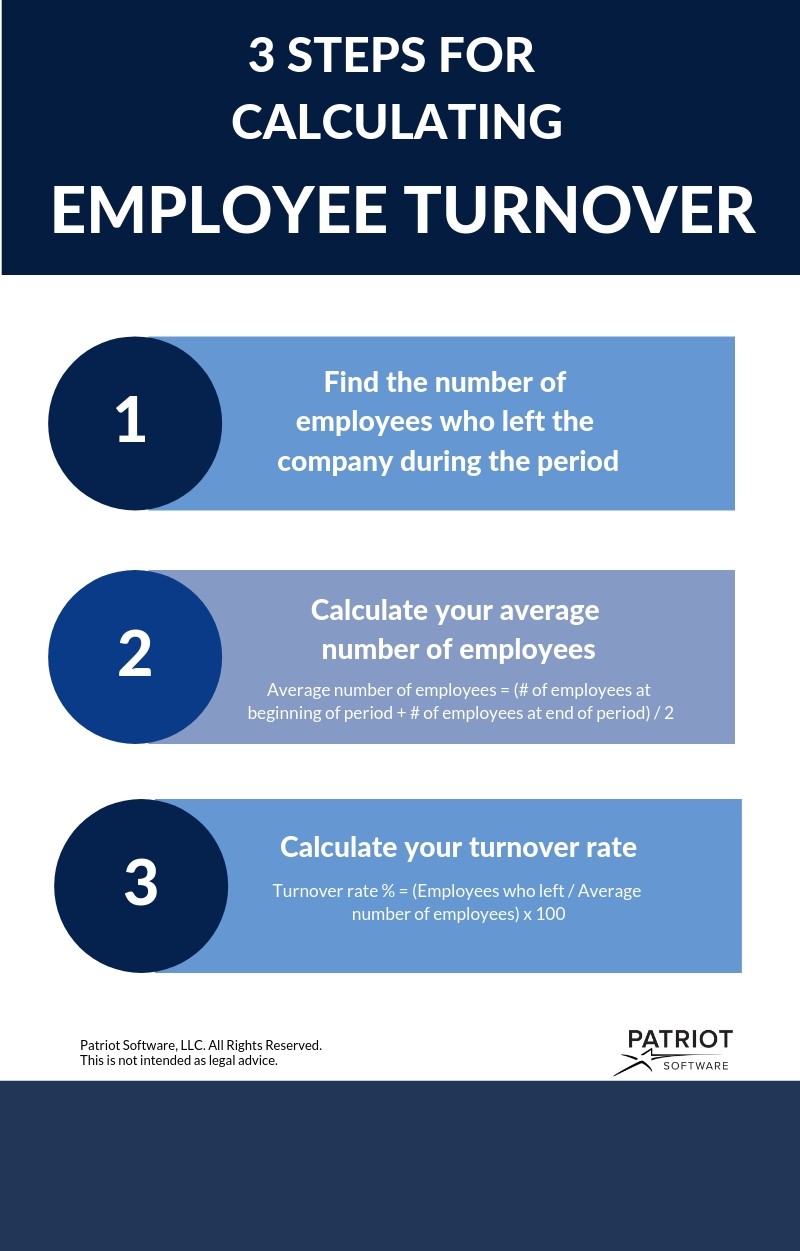All types of businesses experience turnover at some point. And to improve your turnover rate, you must know how to calculate it. Read on to learn how to calculate turnover rates and ways to improve your rate.
How to calculate turnover rate
Before you can calculate your employee turnover rate, you must know what it is. A turnover rate refers to the percentage of employees leaving a business within a certain time period. And, it is one of the human capital metrics your business should track.
Many businesses use a monthly time period to calculate turnover rates. However, some small business may use longer time frames, such as quarterly or annually.
Average turnover rates vary by industry. A turnover rate of 10% may be suitable for one industry while the same rate might be bad for another. Before calculating your rate, research turnover rates for your industry to see where you stand.
According to one source, sectors with higher turnover rates include retail with 13% turnover rate and healthcare with 9.4%.
Having a high turnover rate can be costly. Businesses with higher staff turnover may spend a lot of time replacing employees and filling positions. Because of the cost of turnover, companies should strive to have a low turnover rate.
Steps for calculating employee turnover
To calculate your business’s turnover rate, you need to gather the following information:
- Number of employees from beginning of the period
- Number of employees from end of the period
- Total number of employees who left during the period
Use the steps below to calculate your business’s turnover rate.
1. Find the number of employees who left the company during the period.
2. Calculate your average number of employees by adding your beginning and ending number of employees from the period. Then, divide total employees by two to get the average number of employees.
Average number of employees = (Number of employees at beginning of period +
Number of employees at end of period) / 2
3. Divide the number of employees who left (Step 1) by the average number of employees (Step 2). Then, multiply that total by 100 to get your turnover rate.
Turnover rate % = (Employees who left / Average number of employees) x 100
Example of calculating turnover
Time periods used to calculate turnover vary from business to business. Check out examples of calculating employee turnover below for various time periods.
Monthly turnover rate
Say you had three employees leave your business during the month. At the beginning of the month, you had 20 employees. You have 22 employees at the end of the month.
Calculate the average number of employees for the month by adding the beginning and ending employee totals and dividing by two.
Average number of employees = (20 + 22) / 2
Average number of employees = 21 employees
Find your monthly turnover rate by dividing the three employees by 21. Then, multiply by 100 to get your turnover rate.
Monthly turnover rate % = (3 / 21) x 100
Monthly turnover rate % = 14.28%
Your turnover rate for the month is 14.28%. Follow the same steps to determine quarterly or annual turnover rates using data from time periods throughout the year.
For example, if you want to calculate your Quarter 1 turnover rate, gather the employee totals from January 1 to March 31. Then, follow the steps to find your quarterly turnover rate.
Improving your turnover rate
If you want to lower your turnover rate, you must decrease the number of employees who leave your business.
Find out why your rate is higher than the average industry rate. Analyze your data and compare it to the reasons why employees left your business.
Ask yourself questions like, When do employees typically leave? Why are they leaving? Is there something that my business can do to prevent turnover?
Some employee retention is beyond your control, like seasonal employees or workers who leave due to health issues. Other reasons that may impact your turnover rate include:
- Performance issues
- Ethics violations
- Requesting higher compensation
- Advancement opportunities
- Personal reasons
Pinpoint the reasons why employees are leaving and use that to improve your turnover rate. For example, if lower engagement is causing high turnover rates, look into ways to improve work activities and utilize other advantages of employee engagement.
Regardless of the basis (e.g., monthly), make sure to keep track of turnover regularly. Consistently tracking turnover rates can help you figure out why employees are not sticking around. And, it can help improve employee retention if you find the causes for employee turnover. Consider also conducting exit interviews to pinpoint why employees are leaving.
Do you need an easy way to track your business’s incoming money? Patriot’s online accounting software allows you to manage your incoming and outgoing money. And, we offer free, U.S.-based support. Try it for free today!
This is not intended as legal advice; for more information, please click here.

